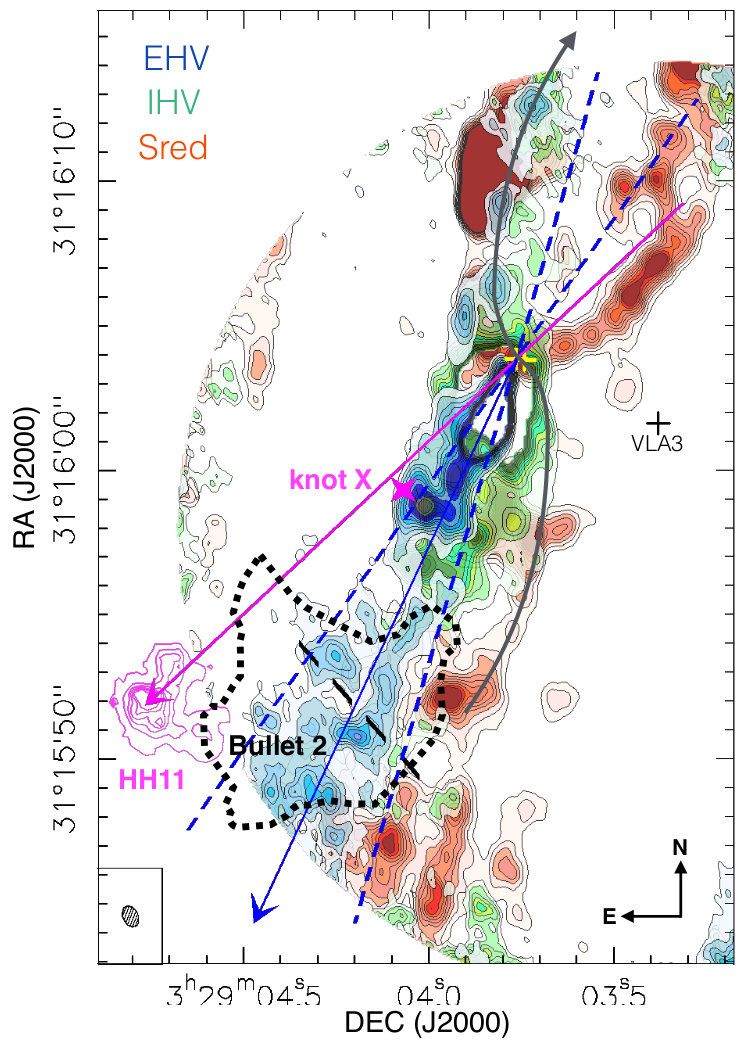
|
EPoS |
|
EPoS Contribution
|
|
SVS13A as Archetype for the Role of Multiplicity in Accretion Bursts and Jets
Sylvie Cabrit Obs. Paris, Paris, FR | |
|
The role of close stellar encounters in accretion and ejection bursts in young stars is a debated issue. An archetypical target of study in this context is SVS 13A, a 0.3" (70 au) binary solar-type protostar in NGC 1333 with recent infrared outburst; this source also shows multiple signs of ejection: it has been considered as the candidate source of the HH7-11 chain, drives high-velocity CO bullets, and hosts small scale [Fe II] jet with H2 arcs. An unusually large angular momentum in CO bullets, compared to other rotating outflows like DG Tau, was recently claimed from SMA maps at 3" resolution and interpreted as a large angular momentum extraction during major outbursts.
Here we present a much higher angular resolution (0.3-0.8") study of the SVS13 A system in dust continuum, CO, SiO and SO, obtained in the frame of the CALYPSO (Continuum And Lines in Young ProtoStellar Objects) Large Program at the IRAM PdBI. The high astrometric precision, angular resolution, and sensitivity reveal the jet structure in unprecedented detail and the key role of multiplicity in its outstanding outflow properties. We find a CO/SiO/SO counterpart to the small-scale H2 jet, with a wiggling pattern consistent with orbital motion around a yet undetected 20–30 au companion, or jet precession. This wiggling combined with jet velocity variability can readily explain away the large apparent rotation across CO bullets, as an artefact of the peculiar jet structure. We also find that the CO jet and the HH7-11 chain do not originate from the same source but trace two distinct jets ejected at slightly different angles from quasi-coplanar disks, separated by 20–70 au. Surprisingly, these two distinct jets appear to experience roughly synchronous major outbursts of period ~ 300 yr. This synchronicity favors external triggering of accretion and ejection bursts by close binary interactions (leading to mutual disk perturbations), a scenario also invoked for FU Or outbursts. | |
 | |
| Caption: Wide field CO maps of the SVS 13A outflow corrected from primary beam attenuation, in three velocity ranges: blue: EHV (150 to 68 km/s), green: IHV (68 to 28 km/s), red: Sred (+10 to +40 km/s). The three arrows show the directions of HH11 (PA = 133 , pink), the wiggling H2 /CO jet (PA = 155 ± 10 , solid blue with dashed blue lines indicating the wiggling opening angle) and a tentative third jet suggested by velocity sign reversal (PA ~ 0 , gray). Pink contours show HH11 (Noriega-Crespo & Garnavich 2001). Dotted black contours outline the EHV Bullet 2 as mapped by Bachiller et al. 2000, which is at a different PA from HH11 but with a similar dynamical age indicating a synchronous outburst. Dashed segment shows where Chen et al. (2016) reported possible rotation. The 70au binary SVS13A (= VLA4A/4B) is indicated as yellow crosses. | |
| Collaborators: C. Lefevre, IRAM, FR CALYPSO collaboration |
Key publication
Suggested Session: Multiplicity |